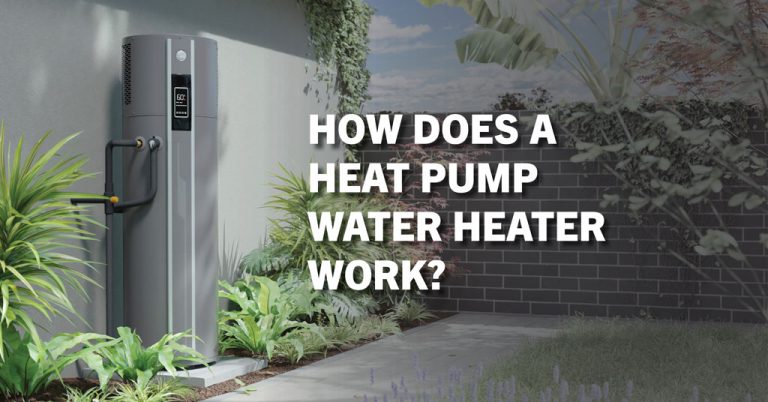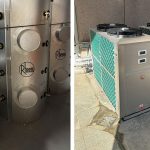Heat pump water heaters are growing in popularity due to their energy efficiency and environmental benefits. In contrast to an electric system which heats water directly using an electric element, heat pumps use ambient heat from the surrounding air to produce hot water, helping Australians reduce their energy consumption and carbon emissions.
These systems work all-year-round, day and night, in sunshine, rain, and even on cold winter nights as there is heat in the atmosphere which can be extracted. In this article, we will look at how heat pumps work to deliver a steady, hot and strong supply of hot water, plus how much you could save on your energy use.
How does a heat pump water heater work to produce hot water?
A heat pump works like an air conditioner on a reverse cycle, moving heat from the air to your water rather than generating heat directly. Here is a summary on how the system works:
- Surrounding air is drawn into the heat pump.
- The air passes through an evaporator coil, where a liquid refrigerant absorbs the heat and turns to vapour.
- The vapour passes through a compressor which compresses it to a high temperature and pressure gas.
- The hot gas passes through the micro-channel heat exchanger which heats the water in the tank.
- With the heat now transferred to the water in the tank, the refrigerant returns to a liquid state.

Heat pumps can help reduce your energy consumption and carbon emissions
Heat pumps are an energy-efficient alternative to traditional electric or gas systems as they produce hot water from a natural source – the heat in the environment. Their efficiency is measured by Coefficient of Performance (COP), which is the ratio of how much useful heat it produces for water heating to the power input into the water heater. The higher the COP number, the more efficient the Heat Pump is.
ALSO READ: A heat pump’s Coefficient of Performance (COP) explained
For context, here is a look at the efficiency of Rheem heat pumps:
- The Rheem AmbiPower 280e Heat Pump® has an average COP of 5.2 at 19oC ambient air temperature, meaning the system produces 5.2 times the heat for water heating as compared to 1kW of electricity consumed.¹
- The Rheem Ambiheat® HDc-270 and Rheem AmbiPower® MDc-180 Heat Pumps have an average COP of 4.5 at 19oC ambient air temperature.
- The Rheem MPi-325 Series II Heat Pump has an average COP of 3.6 at 19oC ambient air temperature.
You can save on your hot water energy consumption when replacing a similar-sized electric water heater by:
- Up to 65% with the Rheem MPi-325 Series II Heat Pump.
- Up to 70% with the Rheem AmbiPower® MDc-180 Heat Pump.
- Up to 73% with the Rheem Ambiheat® HDc-270 Heat Pump.
- Up to 73% with the Rheem AmbiPower® 280e Heat Pump.²
Because heat pumps use less electricity, you can reduce your carbon emissions. Also, new systems are manufactured using more environmentally-friendly refrigerants for longer term benefits to the planet.
Looking to install a heat pump?
If you’re thinking of installing a heat pump, contact your plumber or local Rheem Solar Specialist for more information.
RELATED ARTICLES ON THE RHEEM BLOG:
- 5 reasons to choose a heat pump water heater
- Residential hot water case study: Rheem Ambiheat HDc-270 Heat Pump
- Solar vs. heat pump comparison: Which option is right for you?
Disclaimers:
1. The average Coefficient of Performance (COP) value as mentioned was measured under test conditions with an ambient air temperature of 19˚C/15˚C (Dry Bulb/Wet Bulb) over the entire heat-up process, heating of the water from cold to 60˚C during water heater operation and a power supply of 240 V~ 50 Hz. The Heat Pump average heating capacity in Watts and its water heating capacity in Litres / hour were calculated from the results of this test. The heat pump water heater performance tests were conducted under laboratory conditions. Note that the actual COP of the product at any given time will be impacted by several factors, including the ambient and cold-water inlet temperatures at the place of installation and time of day/season of operation.
2. Energy savings are based on Australian Government approved TRNSYS simulation modelling using a medium load in Zone 3 and apply when replacing a similar sized storage electric water heater. Any savings will vary depending upon your location, type of water heater being replaced, hot water consumption and fuel tariff.




Comments are closed.